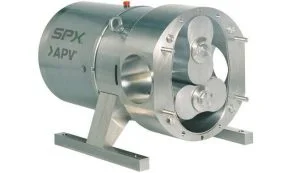
We’re back for another edition of “Know Your Pumps.” This time we take a look at another member of the positive displacement pump family: lobe pumps.
Lobe pumps are similar to external gear pumps in operation, except the pumping elements or lobes do not make contact. Lobe contact is prevented by external timing gears producing a continuous (non-pulsating) discharge.
Pump shaft support bearings are located in the timing gear case. Since the bearings are out of the pumped liquid, pressure is limited by bearing location and shaft deflection. There is not metal-to-metal contact and wear in abrasive applications is minimal. Use of multiple mechanical seals makes seal construction important.
Lobe pumps are frequently used in food applications, because they handle solids without damaging the pump or the product. Lobe pumps can pump much larger particles than can other positive displacement pumps.
Since the lobes do not make contact, and clearances are not as close as in other PD pumps, this design handles low viscosity liquids with diminished performance. Loading characteristics are not as good as other designs, and suction ability is low. High-viscosity liquids require considerably reduced speeds to achieve satisfactory performance.
Lobe pumps are cleaned by circulating a fluid through them. Cleaning is important when the product cannot remain in the pumps for sanitary reasons or when products of different colors or properties are batched.
What Do We Use Them For?
Score Card
| Abrasives
|
Thin
Liquids |
Viscous Liquids | Solids | Dry Prime | Diff. Pressure | |
| How well does a Lobe Pump handle it? |
G |
A |
E |
E |
A |
G |
E = Excellent, G = Good, A = Average, P = Poor
Read on to Learn More About The Differences in a Lobe Pumps vs Gear Pump



Notifications